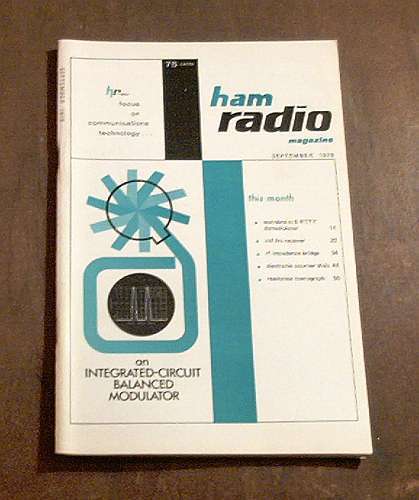|
These all smell a little musty or smoky. Ham Radio Magazine, 1970, 6 by 9 inches September, 96 pages, no mailing cover, staples are rusty * Integrated-Circuit Balanced Modulator. Although designed for balanced-modulator service, the Motorola MC1596G is readily adaptable to many other circuits for amateur use. Roy Hejhall * Mainline ST-5 RTTY Demodulator. This basic building block demodulator featuring linear IC's can be used for future expansion of your RTTY station. Irvin M. Hoff * FM Receiver for Two Meters. Conservative design, solid-state construction, readily available parts-all add up to a really solid VHF FM receiver. Ron Vaceluke * Multimode Transmitter for 6 and 2 Meters. PC-board mixers featured in an earlier article are combined with linear amplifiers and control circuits for improved operation. D. W. Bramer * Simple Bridge for Antenna Measurements. This instrument allows measurement of both resistive and reactive components of your antenna with the aid of the Smith chart. Henry S. Keen * Neutralizing Small-Signal Amplifiers. How to obtain maximum performance from preamps and converters. Earnest A. Franke * Electronic Counter Dials. A direct frequency readout for your receiver VFO using inexpensive ICs. E. H. Conklin * Solid-State Audio Oscillator-Monitor. The basis for this efficient, low-power circuit is an isolated integrator network. N. J. Nicosia * Nomograph for Reactance Problems. An easy-to-use computational tool that lets you solve complex inductive and capacitive reactance problems without mathematics. Alf Wilson * Parasitic Oscillations in High-Power Transistor RF Amplifiers. Robert C. Wilson * CW Transceiver Operation with Transmit-Receive Offset. It's easier to operate CW with a slight frequency offset between direct-conversion transceivers-here's why. Richard S. Taylor * Repair Bench: Finding Faults in RF and I-F Amplifiers. Larry Allen (please look at our rules and privacy policy) |
Sophie.shields@machine--tools.com (Sophie Shields) for additional information. This email is used for forwarding to newsgroup user.
